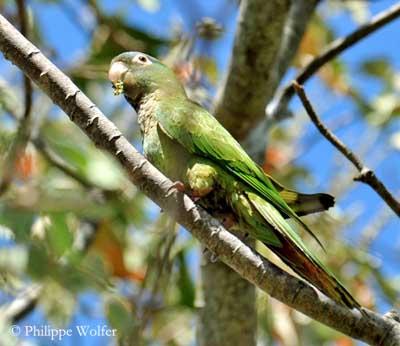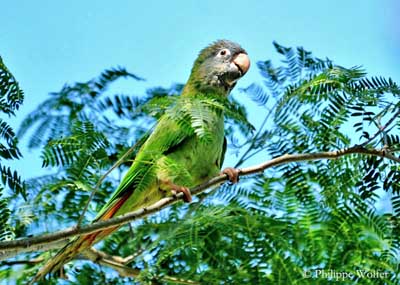
Fr: Conure à tête bleue
All : Spitzschwanzsittich
Esp: Aratinga Cabeciazul
Ital: Conuro testablu
Nd: Blauwkoparatinga
Sd: Blåkronad parakit
Port: Aratinga-de-testa-azul
Photographers:
Jean Michel Fenerole
Photos d’Oiseaux du monde
Philippe and Aline Wolfer
OISEAUX D’ARGENTINE
Text by Nicole Bouglouan
Sources:
HANDBOOK OF THE BIRDS OF THE WORLD vol 4 by Josep del Hoyo-Andrew Elliott-Jordi Sargatal - Lynx Edicions - ISBN: 8487334229
PARROTS OF THE WORLD – An Identification Guide – by Joseph M. Forshaw – Princeton University Press – ISBN 0691092516
A GUIDE TO THE BIRDS OF COLOMBIA by Steven L. Hilty and William L. Brown - Princeton University Press – ISBN 069108372X
BirdLife International (BirdLife International)
Wikipedia, the free encyclopaedia
Blue-crowned Conure or Parakeet
Thectocercus acuticaudatus
Psittaciforme Order – Psittacidae Family
BIOMETRICS:
Length: 33-38 cm
Weight: 170-176 g
DESCRIPTION:
The Blue-crowned Conure is one of the Psittacidae species the most trapped for pet-trade. Declared a pest species in Argentina because they damage the crops, this species, although to be common in its range, has suffered excessive trapping for live-bird market.

The adult has green body, wings and tail, with blue-green tinge on the scapulars and blackish-green tips to the primary flight feathers. On the uppertail, the outer rectrices are brownish-red with dark yellow-green tips.
On the underparts, the breast is sometimes tinged blue.
The undertail feathers are old-gold with reddish inner webs and with yellow-olive tips.
The underwing is old-gold with slightly darker flight feathers.
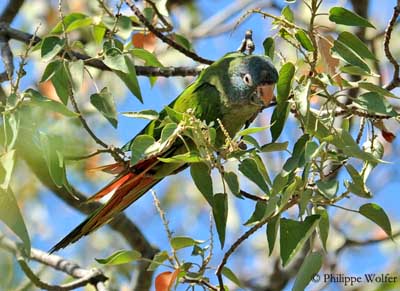
On the head, forecrown, lores, cheeks and ear-coverts are dull blue.
The hooked bill has horn-coloured upper mandible with grey tip, and grey-brown lower mandible. The eyes are orange, surrounded by conspicuous bare whitish eye-ring. Legs and feet are pinkish-brown.
Both sexes are similar.
The juvenile has only blue forecrown and lacks the blue wash on the breast. It has brown eyes.
We can find five subspecies which vary in colours, mainly on the head.
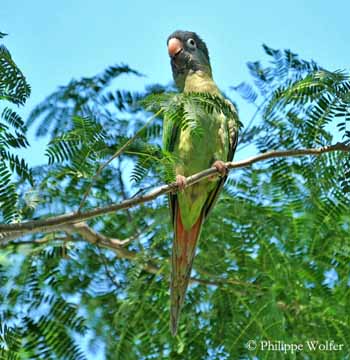
VOICE: SOUNDS BY XENO-CANTO
The Blue-crowned Conure utters a loud “cheeah-cheeah” rapidly repeated in flight. We can also hear gabbling and it utters an almost musical “krraa”.
HABITAT:
The Blue-crowned Conure avoids the closed forest but can be seen at the edges. It frequents the arid thornbush and cactus shrub, and also occurs in dry woodland and gallery forest, open savannahs with Mauritia and Buruti palms. It can be seen in cultivated areas and pastures with scattered patches of trees.
RANGE:
The Blue-crowned Conure is found in large parts of South America in several separated populations, east of the Andes, NE Colombia, N Venezuela, and from N Brazil to N Argentina. It can be visible up to 2600 metres of elevation.
There are feral populations in Florida and S California.
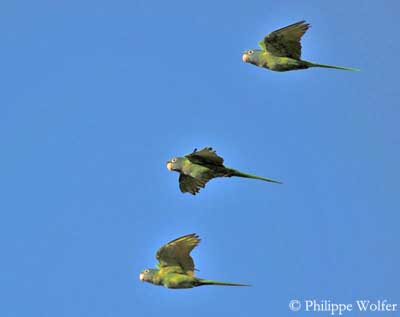
BEHAVIOUR:
The Blue-crowned Conure feeds on berries, seeds, nuts and fruits of large cacti. It damages the crops of corn and sorghum and takes ripe mangoes and also the seeds of noxious weeds.
They usually forage in groups of 10 to 50 birds and more, and can congregate in larger flocks at abundant food sources. They feed in trees and bushes, and also on the ground.
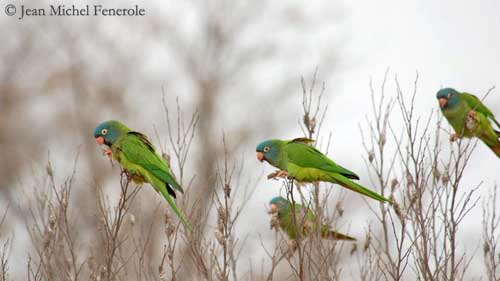
They sleep together at communal roosts, sometimes in rocky crevices in cliff faces, or sheltered in branches in trees.
They perform every day long-distance flights from their roosts to the feeding areas.
The courtship displays involve ritual and mutual preening which is typical in pairs to maintain or strengthen the pair-bonds.
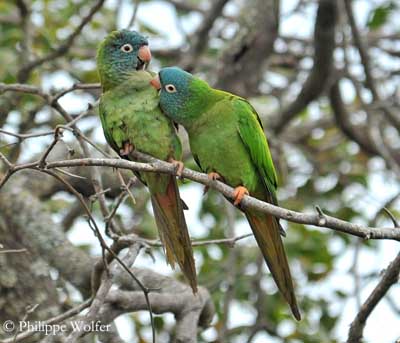
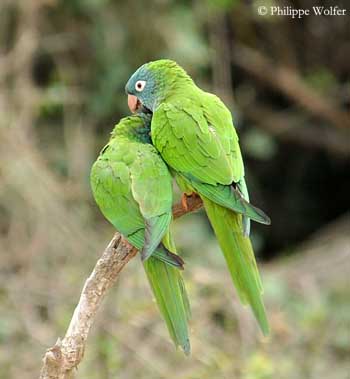
The Blue-crowned Conure performs some movements according to the range. This species is common in Colombia between March and July, but absent the rest of the year.
They also move in response to weather conditions and food availability.
Some races are nomadic and others show complex movements, not still completely known.
FLIGHT:
The Blue-crowned Conure performs strong, direct flight with steady wing-beats.
Over long distances, it flies high in the air. When foraging, they make short flights at low height over the vegetation and the open areas.
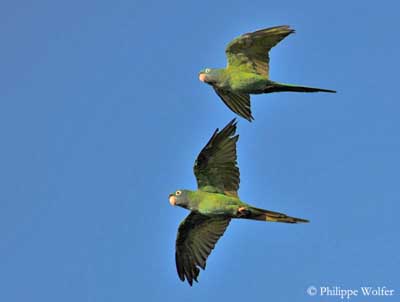
REPRODUCTION:
The breeding season varies according to the range.
The Blue-crowned Conure nests in hole in tree or in hollowed outer branches.
The female lays 2-3 white eggs. The incubation lasts about 23 days, mainly by the female. The chicks fledge 50-58 days after hatching.
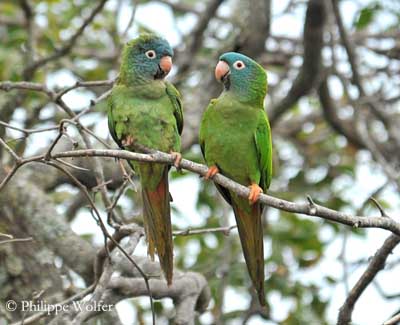
DIET:
The Blue-crowned Conure feeds on fruits such as ripe mangoes and fruits of large cacti. It also takes berries (Condalia lineata), seeds and nuts.
It damages the crops of corn and sorghum, and feeds on seeds of noxious weeds.
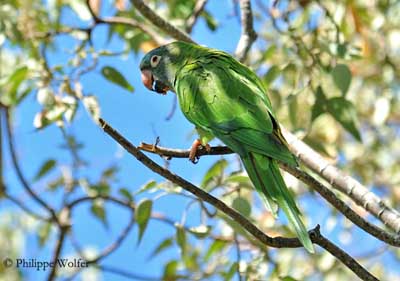
PROTECTION / THREATS / STATUS:
The Blue-crowned Conure is common in most part of the range.
As almost all the Psittacidae species, it is threatened by deforestation and degradation of the habitat. Some races such as “neoxena” are threatened by pet-trade with taking of young for pets. The predation at nest by rats is also an important threat.
However, the Blue-crowned Conure is not currently threatened.
